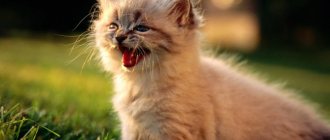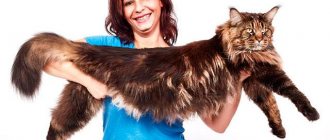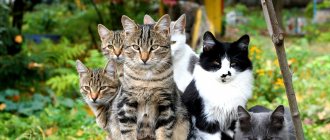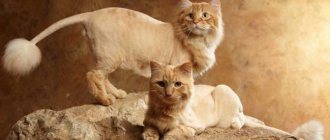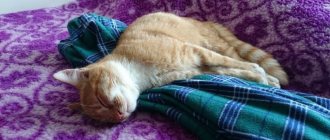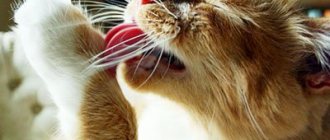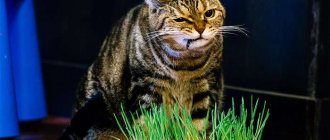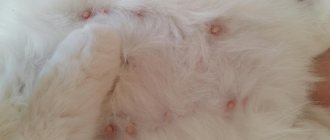The cat family includes 37 species, including cheetahs, pumas, jaguars, leopards, lions, lynxes, tigers and domestic cats. Wild cats live in all regions except Australia and Antarctica. Predators live in different places, but most often in forests.
The fur is decorated with spots or stripes, only the puma, jaguarundi and lion are of a uniform color. Black or almost black fur is found in individuals of several species. The lynx has a short tail, but most cats have a long tail, about a third of their body length. The only cat with a mane is a male African lion. Cats have sharp claws that retract, with the exception of the cheetah. In most cats, the male is larger than the female.
Clouded leopard
It has short legs, a long head, and large upper canines that are proportionally longer than those of any other cat.
Leopard
The solitary animal lives among bushes and forests. Mainly nocturnal, sometimes basking in the sun.
African lion
A muscular cat with a long body, large head and short legs. Size and appearance differ between the sexes.
Ussuri (Amur) tiger
Well adapted to harsh, snowy winters and many different biotopes. Male territories extend up to 1,000 km2.
South China tiger
The stripes of this subspecies are especially wide and spaced further apart than those of other tigers. This gives the fur a bright, impressive appearance.
Bengal tiger
This is a mammal with thick paws, strong fangs and jaws, and fur with a characteristic pattern and color. Males are larger than females.
White Tiger
A striking feature is the fur, the color due to the lack of the pigment pheomelanin, which Bengal tigers possess.
Black Panther
Incredibly smart and dexterous animals that people rarely notice in nature, since they are usually very secretive and cautious.
Jaguar
A lone predator hunts from ambushes. The name comes from an Indian word meaning "one who kills with one leap."
Snow Leopard
The coat consists of a dense undercoat and a thick outer coat that is pale grayish in color with dark spots and a stripe down the spine.
Cheetah
Active during the day, hunting early in the morning and late in the evening. It consumes prey quickly so as not to be captured by lions, leopards, jackals and hyenas.
Caracal
A short-haired cat with reddish-brown smooth fur and long tufts of black fur at the tips of its pointed ears.
African golden cat
Rodents tend to be the most common prey species, but small mammals, birds and primates are also eaten.
Kalimantan cat
For more than a hundred years, researchers could not catch a living cat. She has bright red fur with white stripes on her face and white under her tail.
Temminck's cat
Carnivorous, feeding on small prey such as the Indochinese ground squirrel, snakes and other reptiles, muntjacs, rodents, birds and young hares.
Chinese cat
With the exception of color, the cat resembles the European wildcat. Sandy fur with dark hairs, whitish belly, paws and tail with black rings.
Black-footed cat
Native to the southwestern part of Southern Africa, it lives in extremely dry conditions. It is one of the most brutal predators - 60% of hunting success.
Forest cat
Similar to a domestic cat, but with longer legs, a larger, flatter head and a relatively short tail ending in a rounded tip.
Dune cat
The coat is light sandy to grey-brown, slightly darker on the back and paler on the belly, with sparse stripes on the paws.
jungle cat
Most common in India, Bangladesh and Pakistan, Egypt, Southwest, Southeast and Central Asia, the range is expanding to southern China.
Other members of the cat family
Steppe cat
It slowly approaches and attacks, pouncing on the victim as soon as it is within reach (about a meter). Active at night and at dusk.
grass cat
Color varies from grayish yellow and yellowish white to brown, taupe, light gray and silver gray.
Andean cat
They do not live in captivity. All Andean mountain cats in zoos have died. Fewer than 2,500 specimens are thought to exist in the wild.
Geoffroy's cat
Gray or brown with black markings, 90 cm long, of which the tail is 40 cm. Breeds once a year, litters consist of 2-3 kittens.
Chilean cat
The base color of the coat ranges from gray and reddish to bright brown or dark brown, with small rounded black spots.
Long-tailed cat
Lives in forests, is nocturnal, feeds on birds, frogs and insects. Claws and paws allow you to move through trees and along branches.
Far Eastern forest cat
The coat is usually yellowish or reddish-brown above, white below, and heavily marked with dark spots and streaks.
Oncilla
Lives in mountainous, subtropical forests and semi-arid areas. The oncilla was hunted for its beautiful fur in the second half of the 20th century.
Ocylot
The short, smooth fur is decorated with elongated spots with black edges, they are arranged in the form of chains. The upperparts are light or yellowish-brown to gray.
Pampas cat (bell)
About 60 cm long, including a 30 cm tail. The longhaired fur is grayish with brown markings, which are fuzzy in some cats.
Serval
A slender cat with a long neck, small head and large, slightly cupped ears. Adults range from 80 to 100 cm in length, with the tail accounting for another 20–30 cm.
Canada lynx
She has a short tail, long paws, wide toes, and ear tufts raised high. The fur is light gray, the belly is brownish, the ears and tip of the tail are black.
Common lynx
Considered to be a secretive creature. The sounds it makes are quiet and inaudible; the lynx remains unnoticed by foresters for many years!
Iberian lynx
The basis of the diet is rabbit. During the winter months, when the rabbit population is low, it preys on deer, fallow deer, mouflon and ducks.
Red Lynx
About 2 times the size of a domestic cat. Thick short hair perfectly camouflages among trees under the glare of the sun.
Manul
The broad head with high-set eyes and low-set ears squeezes into rocky outcroppings where rodents and birds live.
Marble cat
The coat is long, soft, pale brown to brownish-gray in color, with large spots with dark edges on the body and small dark spots on the legs and tail.
Bengal cat
Nothing escapes her attention. The cat enjoys playing games and learns tricks. Hunts aquarium and pond fish if he lives in the house.
Iriomotean cat
It is found in subtropical forests on the island of Iriomote, preferring areas near rivers, forest edges and places with low humidity.
Sumatran cat
Adapted for aquatic hunting: long muzzle, flattened upper part of the skull and unusually small ears, large and close-set eyes.
Spotted ginger cat
One of the smallest cat species in the world, about half the size of a domestic cat. This animal is rarely seen in nature.
Fishing cat
The coat is pale gray to dark brown, with dark spots and streaks. Lives near water in jungles, reed beds and swamps.
Puma
Lives among desert scrub, chaparral, swamps and forests, avoiding agricultural areas, plains and other places without shelter.
Jaguarundi
Smooth long body with small ears, short legs and a long tail. Length from 90 to 130 cm, including tail from 30 to 60 cm.
Central Asian leopard
Due to differences in habitat, size and color are difficult to determine. The animals in northern Iran are some of the largest leopards in the world.
Far Eastern leopard
Adapted to cold weather, thick fur reaches 7.5 cm in length in winter. For camouflage in the snow, their coat is paler than that of other subspecies.
Asiatic cheetah
Each cheetah has its own dot pattern on its body. Experts use photographs taken by camera traps to identify animals by their unique spots.
General information about wild cats
Wild cats are found everywhere. The exceptions are the lands of Antarctica, Madagascar and a number of oceanic islands. In a word, where there is eternal ice and no forest. Domestic cats are found in every corner of the globe where people live.
See also: Persian cat: big-eyed aristocrat
The main distinguishing features of all wild cats
A characteristic feature of all cats is a solitary existence, unless a person interferes with this process. All representatives of the cat family are experienced hunters. In the wild they have no equal rivals. They can kill prey larger than their own weight and size. These are usually night hunters.
All wild cats have similarities in appearance, behavior and habits.
The animals have a short mouth with small molars that are located next to the fangs. The teeth of all wild cats are well developed. Long fangs are ideal for penetrating the victim's body.
The cat family has retractable claws. There are strong fluctuations in body weight among cats. This interval ranges from one to three hundred kilograms. Males have more strength and weight than females.
The length of the coat depends on the climatic regions where wild cats are found. The lower the temperature, the thicker and longer the animal's coat. The snow leopard is a good example. The coat color varies depending on the type and age of the animal, and amazes with its mysterious patterns.
This camouflage allows them to be invisible while hunting and not become easy prey for their enemies. For example, small pumas have spotted coats. In adults this color is very rare.
Most species of the cat family have large eyes. The tongue resembles sandpaper. This feature makes it easy to hold food in the mouth and separate pieces of meat from bones.
Wild cats can walk on their toes. This is the main reason for their enormous speed of movement, which makes them excellent hunters among other carnivores. Wild cats of any kind are characterized by an active lifestyle at night.
See also: Chausie cats
Large cat species give birth to no more than four kittens. In small individuals, six cubs are born at once. The mother takes care of the helpless and blind kittens. The father does not take part in this.
The life of wild cats lasts on average about thirty years.
Habitat and role of desert cats in the ecosystem
Arabian cats inhabit the driest places on the planet. The main requirement for the site is the presence of dunes, dunes and dry bushy plants. The main settlement areas are located in the following parts of the planet:
- Sahara (Morocco, Algeria, Niger, Chad);
- Arabia Peninsula (Arabian Desert);
- central Asia (Kazakhstan, Turkmenistan and Uzbekistan);
- Pakistan.
Every animal has its place in the ecosystem. If the need for a species is lost, then its representatives cease to exist. The sand cat has only recently been studied, but it is clear that it appeared long before it was discovered by the French. This means that nature still needs this small predator. Desert cats exterminate rodent pests and can kill snakes. The cats themselves can suffer from larger predators (for example, lions). All this characterizes the sand cat as one of the links in the food chain.
Fold
Discussions about the ancient purebred cats of China are impossible without mentioning the legendary fold-eared breed. The Chinese Fold is the subject of controversy, scandals and numerous scientific disputes in the world of cat lovers. Chinese felinologists insist on the ancient history of selection and breeding of the lop-eared species, confirming the information with numerous references in historical documents and images on the crafts of blacksmiths, engravers, painters and potters of the Celestial Empire. Chinese historians claim: fold-eared cats lived in the palaces of the Chinese nobility and were used to hunt small game, but at a certain point they went out of fashion and were lost as a species.
The world expert community responds by referring to the British history of the specific design of cat ears. The debate has been going on for a long time and to no avail. The bottom line is the only fact: not a single world federation recognizes the existence of the Chinese fold breed.
Cultural significance
Bolivians consider the titi to be a sacred animal. Locals perform various rituals for good luck using body parts, skins or stuffed Andean and Pampas cats. The former promise a successful harvest, protect livestock from disease, and silver “kolke-titi” attract wealth.
Villagers believe that Andean cats belong to Pachamama, the goddess who personifies Nature. If upon meeting her pet is friendly towards the person, the next year will go well. If a cat hisses or attacks, expect trouble. The hunter who killed the cat finds himself in Pachamama's debt. He must repay her by performing a religious ritual.
A stuffed animal is made from the prey - the skin is filled with wool, decorated with ribbons, colored threads, coins, and coca leaves. The remains are buried at the site where the cat died. The shaman illuminates the effigy, which the hunter and his family will worship for many years to come. As long as the totem is treated with respect, men can go fishing without fear of the wrath of the goddess.
Members of the Andean Cat Union conduct educational activities among the local population, bringing state laws to remote communities, explaining the importance of preserving rare species. Together with government officials, they participate in organizing agricultural activities and tourism in areas important for the revival of the population.
Life in captivity
The main knowledge of zoologists about the Chinese mountain cat is based on observations of the animal not in its natural habitat, but in captivity. Thus, in the zoo in Xining (China), more than thirty animals were studied for twelve years, which provided a wealth of material for scientists. But these data may not fully reflect the natural behavior and lifestyle features of this little-studied species.
Features of care
Chinese mountain cats are unsociable, capricious and aggressive; This species is completely unsuitable for keeping in apartment conditions. Any attempts to tame wild animals are doomed to failure, even if the kittens were taken from nature when they were very young.
The Chinese mountain cat tolerates captivity well, but is never tamed
Feeding in captivity should be based on a natural diet consisting of 90 percent fresh meat, poultry and small amounts of fish can also be included. Consult your veterinarian about what vitamin and mineral supplements and in what dosages may be recommended for a particular animal.
Pets must be vaccinated. In childhood, comprehensive vaccination is carried out at eight and twelve weeks, and then repeated annually, along with rabies vaccinations.
Video: this is how a rare animal is sold at a Chinese market
The fashion for keeping exotic wild cats in captivity has done a disservice to an already vulnerable species. The Chinese mountain cat has become the object of smuggling trade, despite international legal prohibitions. You need to remember that this animal is absolutely not tamed - and only after that should you consider purchasing it.
Binturong
Binturong
Another name for it is “cat bear”. It is very true, since outwardly this animal really resembles both a bear and a cat. From the bear, the binturong took a clubbed gait, a clumsy body, short legs, dark, coarse fur and rather large dimensions. Body length - from 60 to 90 cm, plus a tail of the same size (if not larger), weight - from 12 to 20 kg. What stands out in his appearance is his almost white mustache and dashing tufts on his ears. It is clear that these are no longer bearish signs.
Binturongs are common in tropical forests of Asia. These are nocturnal animals that swim, dive and climb trees well. True, the heavy binturongs cannot jump, but they have a very tenacious tail, thanks to which they maneuver among the branches. They feed on small rodents, birds, fish and carrion.
Binturongs are calm, lazy, non-aggressive, trusting animals that some people decide to keep at home. Why someone? Yes, because these cat bears have one unpleasant quality - they pee everywhere and very often, since nature has endowed them with uncontrollable urination. In some countries, binturong meat is a real delicacy.
Habitat
They live in alpine meadows, steppe pastures, mountain shrublands, and on the edges of high-mountain coniferous forests from 2500 to 5000 meters above sea level. Their dense fur helps them withstand extreme mountain climates. Although Felis bieti is sometimes called the “Chinese desert cat,” this species does not live in desert areas.
Reproduction
Little is known about the breeding system of Gobi gray cats, but they are closely related to jungle cats, which exhibit mate promiscuity, meaning that both sexes, males and females, mate with multiple partners. This species lives in solitary burrows, except during the breeding season, when the female and male live together.
The breeding system is polygynous. Mating occurs from January to March, and kittens are born in May. The gestation period is unknown. The number of kittens in a litter varies from 2 to 4. Mothers care for the young generation in burrows, where they are safe from predators. Kittens become independent after 7-8 months. Wolves (Canis lupus) and brown bears (Ursus arctos) can kill cubs.
There is no information regarding parental involvement in raising the offspring, but among their relatives, the marsh lynxes (Felis chaus), females are responsible for raising and feeding the kittens. Fathers sometimes stay close to defend the territory.
History of the species and the process of human domestication
Moreover, the cat often catches mice everywhere, and not in a place strictly specified by the owner. However, this proximity suited both sides, so now we have many practical and aesthetic cat breeds, united by one genetic ancestor.
Now wild steppe cats prefer not to establish contact with humans. They can be seen near houses only in winter, when rodents move from the fields to barns, around which wild cats hunt.
INTERESTING: until 2022, the species had 15 subspecies, but now such a broad classification is no longer valid. All steppe cats are divided into only three subspecies: Asian, South African and African steppe cats. They are all essentially the same species, but have a number of external differences due to their habitat.
All steppe cats, regardless of subspecies, are listed in the Red Book with a rating of 4 - a small population with unknown dynamics. This is due to the survival of cats from wild places by civilization and crossing with domestic cats, which erodes the purity of the population of both sides.
Who does it hunt and what does it eat?
A predator, in order to survive, must constantly be in shape. The predator shows all its best qualities during the hunt, which is necessary not only to feed itself and its offspring, but also to train agility and speed that allow it to elude other, large predators.
The animal can hunt at any time, but still prefers twilight. To catch food, the animal can hide and wait for the right moment in ambush or track prey by sound and smell. To catch a small bird, a predator does not need many attempts; it pounces on its prey suddenly and almost always gets what it wants. The diet of the Andean cat includes small birds and their chicks and bird eggs. It doesn’t mind eating insects, reptiles, small mammals, and some plants. The most common prey is chinchilla and mountain whiskey.
Did you know? Animals hunt at dusk because they can see in the dark, thanks to the ability of their eyes to reflect light, and their victims do not have this ability and are more defenseless at this time of day.
Li Hua
The Chinese Li Hua Mau (international name of the breed: Dragon Li) is an ancient breed of short-haired endemic feline native to the northeastern foothills of Tibet and the adjacent Mongolian steppes. Manuscripts of the imperial Tang dynasty claim that a wild Gobi cat visited a Chinese village, chose a house on the outskirts and notified the peasant family living there about further peaceful good neighborliness. The peoples of the empire liked their calm, friendly disposition and talent for destroying small rodents: miniature tigers quickly spread throughout the country.
No designer genetic mutations, no interbreed matings that improve the phenotype: all the splendor of the Chinese Li Hua breed is in its pristine and natural nature.
Good nature and human focus, honed over a millennium of domestication, supported by the strength and graceful grace of predatory hunters, make Dragon Lee a significant figure in the cat world.
Chinese cats amaze with their ideal proportions, excellent health and predatory power. The imperious squint of his emerald-green or golden-yellow long-eyed eyes reminds those around him that this is not an ordinary sofa cat, but a beast, albeit tamed.
Chinese and overseas breeders (the breed is very popular in the USA) admire Li Hua Mao's affectionate nature, calm nature and amazing intelligence. Playful and dynamic striped dragons easily adapt to any living conditions, get along well with other animals, and are amenable to education and training.
Content Features
The advantages of this type of four-legged friends are that they are not picky about their maintenance. They have evolved naturally, and therefore have fewer health problems, which is why the “Chinese” are very easy to care for.
It is necessary to give the animal all its vaccinations and take it outside from time to time. The “Chinese” are very freedom-loving, so you can’t lock them within 4 walls. You can bathe such cats no more than once a month. Naturally, if your pet gets dirty, wash it to avoid skin problems. Any food is suitable for the “Chinese”: both ready-made food from manufacturers (dry or wet) and natural food
If you choose food, please note that it will be better if you choose premium class products and higher. These animals need vitamins and carbohydrates, and these lines have the maximum amount of them
Your ideal choice would be Royal Canin or Acana Regionals Grasslands Cat.
If you are a supporter of natural nutrition, then you should remember about the carbohydrates necessary for energy production, as well as the proteins contained in eggs and meat (pork, chicken, hare, turkey, boiled boneless fish).
The diet must include various cereals (barley, arnautka, barley). And also kefir, yogurt, cottage cheese, but with reduced fat content.
It is worth thinking about preserving the furniture in the house and installing a scratching post for your pet so that he can always sharpen his claws if he wants.
Now let's talk about hygiene. Nails need to be trimmed once a month. Every day, wipe your eyes with tea leaves or special veterinary compounds. Clean your ears once every 10 days with a cotton swab. Brush the coat once a week, but this should be done carefully, since the “Chinese” have almost no undercoat. Veterinarians consider it necessary to brush your pet’s teeth with a special brush and toothpaste every 5 days.
Caracal
Caracal
is a steppe lynx, but more graceful and long-legged. Body length is about 80 cm, tail is a little more than 40 cm, weight is about 15 kg. The “highlight” of the caracal is the large and very cute tassels on its black ears. Hence the name: translated from Turkic “caracal” means “black ear”. The fur is brownish in color, very dense and soft.
The caracal makes its home in rock crevices or burrows, and very often it occupies strangers - foxes or porcupines. The caracal cannot run for long, but nature has given it amazing jumping ability. He hides, and when he sees prey, he is able to catch up with it in a few jumps. He knows how to grab a victim “in flight”, and manages to grab several birds at a time! Its main food is rodents, hares, small antelopes, snakes, foxes, mongooses, as well as domestic animals and birds. The caracal, of course, cannot eat the killed victim right away, so it hides it high on a tree.
Caracals are common in African and Asian areas with low and sparse vegetation.

